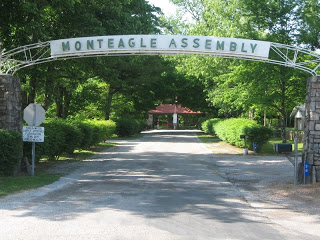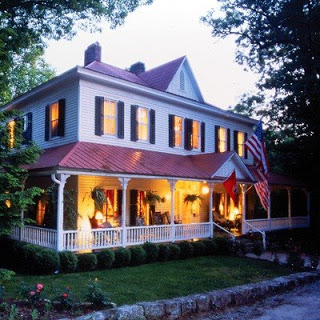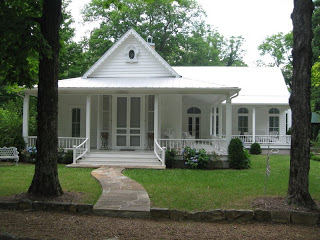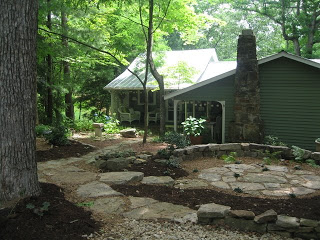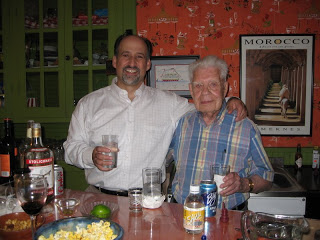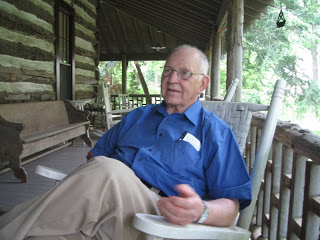From the mountain top
I recently went to Tennessee to teach a workshop on keeping spiritual journal at the Monteagle Sunday School Assembly on the mountain top near Sewanee (not to be confused with the river or the song of similar name).
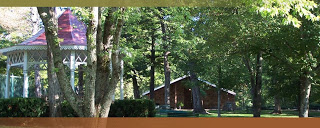
Okay, I admit it, as the Best Beloved and I drove from the Nashville airport toward the South Cumberland Mountain Range, I found myself humming the theme song to the Beverly Hillbillies. I’m not proud of it, and it shows you how little I know about the south. What little I do know about the south has, in part, been gleaned from a stupid set of prejudices (is there any other kind?), childhood memories of visiting my grandparents in Florida as a kid, and bad television.
But I have also had the good fortune of falling in love with southern writers like Madison Smart Bell, Walker Percy, Kate Chopin, Tennessee Williams, Katherine Ann Porter, Eudora Welty, Zora Neal Hurston, Carson McCullers, Flannery O’Connor, Ernest Gaines, Truman Capote, William Gay, and all those others. Their words, rich with that King James version of the Bible cadence and rhythm, helped me fall in love with literature.
The Monteagle Bible Assembly is an old community, or, I should say, an old church. It’s Charter, which was granted by the State of Tennessee on October 31, 1882, states the purpose of the Assembly:
the advancement of science, literary attainment, Sunday School interests, and the promotion of the broadest popular culture in the interest of Christianity without regard to sect or denomination.
By the way, that bit about ‘without regard to sect or denomination is apparently meant in the broadest sense, since my Best Beloved, who is Jewish, was welcomed with the same warmth and grace as I, a plain old Episcopalian.
I am told that whereas there were once hundreds of such Assemblies, patterned after the Chautauqua Institution in New York, in the late 1800s, only nine or ten remain active today. In 2007, Monteagle celebrated its 125th year of continuous operation and was placed on the National Register of Historic Places by the US Department of the Interior.
What is a Chautauqua, you might ask? I stayed at the charming Edgeworth Inn and I take this from their website:
Many families in the Victorian Era left the cities in the summertime and spent two to three months in the nearby mountains. This exodus to the more natural and cooler setting was motivated not only by a desire to escape the summer heat and to relax, but also as a serious quest for physical and spiritual well-being.
The Chautauqua was a natural consequence of such informal gatherings ofpeople from all walks of life. The idea was first proposed at the 1873 Methodist Episcopal camp meeting in Chautauqua, New York, by John Heyl Vincent and Lewis Miller. Inspired by the Lyceum movement, these men suggested combining the summer retreat with eight week programs offering members secular and religious instruction as well as lectures by authors, explorers, musicians, and political leaders. Somewhere between revival meetings and country fairs, Chautauqua were attended by thousands each year. The combination of education and entertainment in a pristine mountain setting caught on rapidly; the Chautauqua Movement spread throughout America and Europe during the latter part of the 19th century
My own grandfather, on my adopted mother’s side, was something of a southern Victorian at heart, and he always insisted on summers filled with healthy outdoor activities, good reading, intelligent conversation and enriching study. Maybe that’s why I have such a soft spot for this stuff.
Okay, but what, exactly, is this particular place? I was told by my friend Milly that it was paradise. Okay, but driving along the highway, past the CVS drugstores and Piggly Wiggly grocery store, the bars (one actually named “The Hillbilly Bar”) and army surplus, the filling stations and the check-cashing joint boasting a large “McCain-Palin” sign outside, I was feeling a little dubious. Then, at last, we found the road leading to a little stone gatehouse. No one was there, but they’d thoughtfully left the gate up, so in we drove.
Good heavens. Leafy roads curve every which way, and everywhere we look cottages, with deep, shaded verandas sporting hammocks and rocking chairs and lanterns, nestle beneath tall trees. Some cottages are Victorian, with scrolls and peaks and gingerbread, some are log cabins, with porch rails of bent wood. Green and blue and sparkling white, pink and yellow.
Hydrangeas, impatiens, geraniums, rhododendron, are everywhere. Wooden footbridges span hollows, and the roads are curbed in place
s with old carriage blocks, set there so the ladies descending from carriages wouldn’t sully their footwear or hems in the mud.
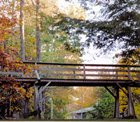
Assembly Bridge
Dede Clements, proprietor of the at the Edgeworth Inn, greets us with an invitation to a cocktail party at Weezie and Bill Blair’s. Just as days in the Assembly are spent in sportive recreation, attending lectures, artistic and literary pursuits, worship and fellowship, many evenings at the Assembly are spent going from one ‘porch party’ to another, watching films in the community hall or attending dances. We didn’t get to the movies or the dances, but I can tell you that each porch is more glorious than the next. People could not have been kinder, nor more interesting. Walter Pulliam, for instance, a 94-year-old retired newspaper man from Knoxville, who had an audience with Pope Pius XII in 1944 when he was a reporter for Stars and Stripes. He later went on to work at the Knoxville News-Sentinel, The Washington Post, and The Harriman Record, which he later bought. Oh, the wonderful stories he told of being at Solerno during WWII, and the munitions ship that exploded, and which no one reported, for fear of tipping off the enemy!
The Best Beloved with newspaper man Walter Pulliam, at the bar in Walter & Julia’s house.
Then there is Bev Douglas who now owns the log cabin where Andrew Lytle, author of The Velvet Horn, among other things, spent the last twenty years of his life, regaling visitors, both literary and local with his story-telling. Bev may be a bit quieter than Old Andrew was, but his hospitality is just as warm, and the twinkle in his eye just as bright. He sat in a rocker on the deep porch and told us about his sister Anne, a child prodigy who taught herself to read at the age of three, and learned to paint all by herself. As a young child, she once painted a picture of horses in a field. Not so amazing, except that she did it by painting, without benefit of preliminary sketch, from the bottom of the page up, in two-inch increments. First the grass and flowers, then the hooves and legs, then the withers, and the shoulders and necks, the heads… and so on. No one could ever figure out how she did either, although she was studied by educators for years.
Bev grinned, chewed on his pipe and said, “My mother told me my job was to take care of Anne. Those of us who do not have the blessing of genius are obliged to support and encourage it.”
And thus, wandering from one porch to another, we meet the people of Monteagle, many of whom have been coming to the Assembly every summer for six generations.
It is in this cloistered, slightly (?) eccentric Pollyanna setting that I am to lead a two day workshop on “Sacred Conversation – Keeping a Spiritual Journal.”
I enjoy teaching creative writing workshops and courses, all of which I consider to have a spiritual component, since I believe the act of writing is by nature spiritual. However, in creative writing classes that aspect is often somewhat buried beneath the search for narrative structure, pacing, character development and significant sense details. In a workshop on keeping a spiritual journal, the spiritual component is right up front where everyone can see it. Rather like the southern eccentric – set up in the middle of the living room, where everyone can enjoy him.
This comfort with eccentricity, by the way, is one of the things I love most about the south, and it is also that which so attracts me to certain areas of the Canadian Maritime provinces and to pocket of lovely wackiness in England.
Tomorrow, or possibly the next day (I am supposed to be on vacation, after all), I’ll write about what we explored in the spiritual journaling workshop. But now, since I’m in Newfoundland at the moment, and there is an iceberg floating past the lighthouse in the bay in front of the house The Best Beloved and I are renting, I can’t keep myself at the computer any longer. Writing and spiritual journal keeping are both, after all, about paying attention and being engaged with the world, right?
Tune in again… more shall be revealed…
